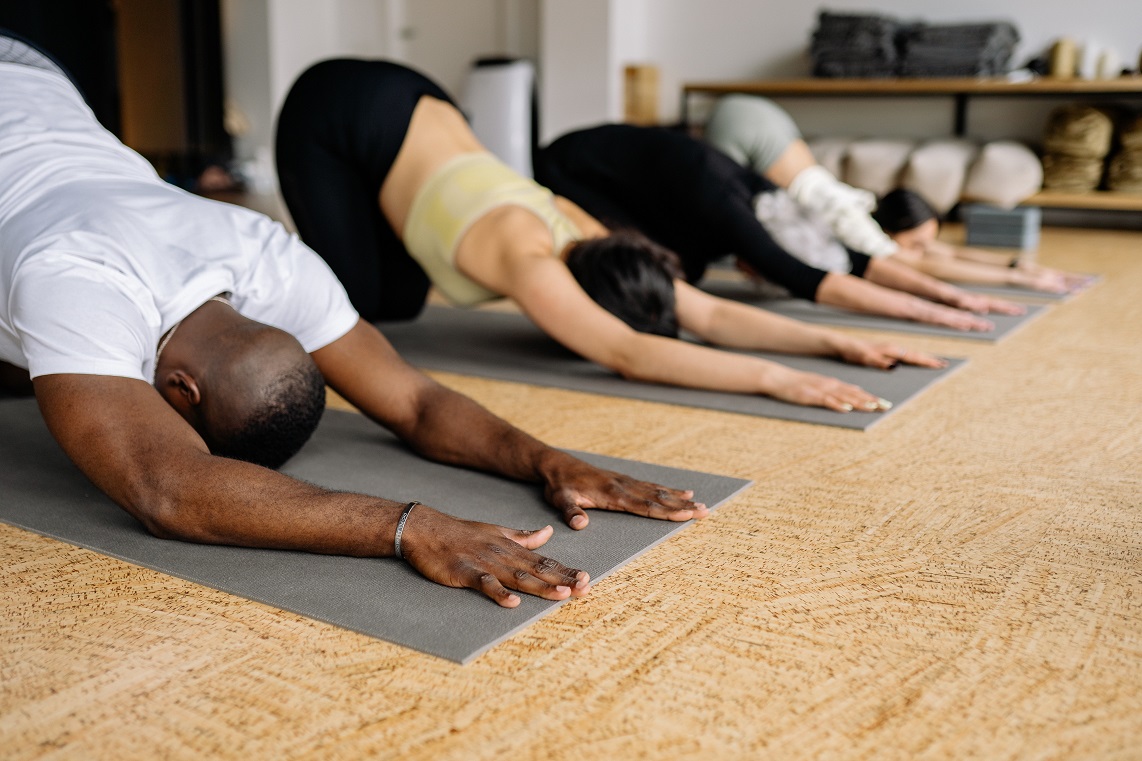
Yoga can help you improve your flexibility. Yoga can help with stiffness and joint pain. If you're new to the practice, it's easy to feel limited by the lack of flexibility in your hips and hamstrings. This inflexibility can result in poor posture and strain on your knee joint. It also decreases levels dopamine or serotonin which are neurotransmitters known to improve mood and reduce anxiety.
A study found that yoga has a positive effect on chronic low back pain. This condition is the most common in veterans. It can greatly impact one's quality-of-life. Participants in the study reported lower disability scores and intensity after a 12-week-long yoga program. The participants also experienced a significant decrease in opioid usage, which is good news for people with chronic low back problems. The benefits of yoga have been extensively documented.
Many yoga moves can help you reduce stress. These yoga exercises can improve your overall health, as well as increasing lymph flow. During practice, you'll increase the lymph drainage system, which is a vital part of the body. The lymphatic system is responsible for preventing infection, destroying cancer cells, and disposing of toxic waste products. Yoga can improve your sleep by reducing stress levels.

Stress can make constipation worse. Yoga can help by improving your posture, flexibility, and overall health. It can also help reduce suffering which can be a big benefit. Constipation is also a common result of stress. Yoga can help reduce constipation. Yoga can help you become more present in your thoughts, which will improve your ability to focus, learn and retain information.
Research has also shown that yoga may improve your heart health. It has been proven that yoga can increase hemoglobin levels in the blood. This is the protein which carries oxygen to tissues. This is yet another positive effect of yoga. This can not only improve your heart health but also lower the risk of stroke and other cardiovascular diseases. It has been shown to increase muscle strength and flexibility in the hands and feet. It can also improve balance which is important in a number of ways.
The benefits of yoga extend to the spinal discs. The discs between the vertebrae play a crucial role in preventing nerve compression and herniated disks. Keeping these discs mobile helps the disks in the spine get the nutrients they need. It is important to practice yoga in a variety poses to keep your spine healthy. It is possible to improve the flexibility of your muscles by performing asanas in this pose.
Yoga is well-known for its healing properties. Yoga can be used to combat anxiety and depression. In a 2015 study, researchers found that participants who performed yoga twice a week had lower levels of stress and improved cardiovascular function. This means they are less likely for heart disease. While this is a small benefit, it's one of the most powerful. As an added bonus, it helps them feel better about themselves and their bodies.

As with other forms of exercise yoga improves your heart. Because it pumps blood throughout the body, this is why yoga is so beneficial. This means that it helps to improve the overall health of the heart. This helps lower your risk of developing heart disease. Yoga can improve your cardiovascular health and lower your risk of developing heart disease. There's no reason to avoid this exercise.
In addition to promoting physical health, yoga can also reduce the symptoms of heart disease. It slows the progression of cardiovascular diseases by reducing the levels of cholesterol and other inflammatory compounds. It has been proven to reverse DNA changes and lower cortisol. It can protect against heart attacks, migraines, osteoporosis, and other conditions such as strokes. It's also good for your mental health. It can help you manage stress and improve focus.
FAQ
What is butter good for?
Butter is one of many good sources of saturated fats. This type fat is great for your skin and hair. It also helps you build stronger bones.
Butter also contains vitamin K, which prevents bleeding from cuts and bruises. Vitamin K and vitamin B work together to prevent any bruising.
Butter is also rich with minerals, such as calcium and phosphorous. These elements encourage stronger bones.
Butter has its limitations. Butter is high in cholesterol. There are studies that show excess cholesterol may increase the likelihood of developing cardiovascular diseases.
Butter is also high-fat, which can contribute to obesity and increase cholesterol.
You can spread butter on bread if you are forced to use it. Bread absorbs less oil than pasta and potatoes.
What is a good daily gym routine?
Regular exercise is key to staying healthy. It doesn't make a difference what kind of activity you choose. As long as you do it often, it will be beneficial. Consistency is the key. If you want to achieve results, you must stick at it for an extended period.
Begin small daily activities like walking. Then gradually increase the time spent exercising until you spend 30 minutes a day working out. You can do this running, swimming weight training, yoga or aerobics classes.
It is important to exercise every day of the week. If you have a reason to miss a session, don't skim it.
If you exercise outside, ensure that you wear appropriate clothing and footwear. Also, consider weather conditions and how they might affect your ability or safety while exercising.
Make sure that you drink plenty of water while you're exercising. Drinking alcohol at this time can lead to dehydration. Avoid caffeine-rich drinks like coffee, tea, and coca. They may give you energy, but they will also dehydrate you.
When you first start exercising, you might feel tired after completing your workouts. You'll feel more energetic and refreshed if you keep going with your exercise program.
How many times a week should I exercise?
It all depends on your time and the type of exercise that you enjoy. It's a good idea to do moderate-intensity aerobic exercises 3 - 5 times per week. It is important to not overdo it. To get the best results from your exercise, it is important to be consistent.
What exercises are the best?
It all depends upon your fitness goals. Some people choose to focus on endurance activities, such as swimming, cycling, and running. Some people enjoy lifting weights and using resistance bands. There are many types of exercise programs today. You can choose the one that best suits you.
Can I go to the gym seven days a week?
Yes, you could go to the gym seven days per semaine but not all at one time. You need to find a time that you are able to do this without feeling exhausted or drained.
This will keep you motivated and provide energy for other activities.
It is important to eat right during these times. This will help you not feel tired or slow at the gym.
Last, you must make sure that there isn’t another thing competing for your attention. It is possible to skip exercising on school nights if your children are involved.
Why Metabolic Health Is the Key to Aging Well?
People are living longer today than ever. They are also becoming more sick as a result. While medical science has made incredible advances, it's becoming increasingly obvious that the current approach is not working.
We have to change how we see health and aging. Healthful aging requires that we start to think about metabolic health, which is not only weight loss but overall well-being.
And if you want to live an active life for decades to come, you should ensure that your metabolism stays strong and healthy throughout your entire lifetime.
There are many options to improve your metabolic health. One way is to include these 7 foods in your diet.
-
Resveratrol is a component of blueberries that has been proven to improve cellular longevity. They also contain vitamins C & E, as well as antioxidants.
-
Lentils and pinto beans, which are legumes, provide great fiber and plant-based sources of protein. These nutrients help maintain blood sugar levels so they don’t spike and fall.
-
Broccoli contains sulforaphane, shown in studies to protect cells against DNA damage. It might even slow down the progression of cancer.
-
Chia Seeds are high-in omega-3 fatty acids, fiber, and other nutrients. They are also rich in antioxidants, protein, and fiber. All these nutrients support heart health, brain function and gut health.
-
Green tea contains catechins, which are polyphenols. Green tea catechins have been shown to reduce bone fractures, heart disease, cognitive decline, diabetes risk, and other health issues.
-
Salmonis rich in vitamin D and low in saturatedfat, salmon is one of the best sources for lean protein.
-
Walnuts are rich in omega-3s as well as antioxidants such alpha lipoic acids (ALA). ALA is an antioxidant that protects against inflammation. It also boosts energy production.
Statistics
- According to the American Heart Association, blood pressure should be checked at least once every two years, beginning at age 20. (my.clevelandclinic.org)
- By John Thompson Take a whopping 38% off a set of PowerBlock Pros. (menshealth.com)
- An estimated calorie range for moderately active adult males falls between 2,200 to 2,800 calories per day, depending on age. (eatright.org)
- Candidates and applicants must pass all four tests at 70% (minimum level) to graduate from Basic Deputy U.S. Marshal (BDUSM) Training. (usmarshals.gov)
- Are You One of the 20% of Guys (mh.co.za)
External Links
How To
What should I eat before a workout?
Losing weight requires you to consume fewer calories than what you burn in exercise. Also, you must eat all the nutrients.
These include protein, carbohydrates and fats as well as vitamins.
It is better to eat smaller meals throughout the day than three large ones.
If you are too hungry when working out, you might not perform as well as if you had appropriately eaten beforehand.
Drinking water is a better option than energy drinks high in caffeine and sugar. This keeps you hydrated and energized.
You should ensure that you get enough fluids. You could lose electrolytes if you drink too much water.
For proper functioning of your body, electrolytes are necessary.
Sports drinks are an option if you don't have water. They can be rich in minerals like sodium, potassium or calcium.
This help replenishes lost electrolytes. However, these won't replace any electrolytes that you might have lost from sweating.
You could also consider taking a multivitamin tablet if you are concerned that you might lose too much salt from exercising.
These supplements contain additional vitamin B6, which can help regulate your body's sodium levels.
If you don't know the salt content of your foods and beverages, supplements shouldn't be relied upon.
They aren't regulated by the Food and Drug Administration (FDA).
Some sports drinks may contain more sodium than others.
Some sports drinks may contain artificial sweeteners or other preservatives. These could cause digestive problems.
If you are concerned about over-salting, you can use sea salt.
It contains less chemicals than table sodium.
Sea salt also lacks iodine. This mineral is important for healthy thyroid function.